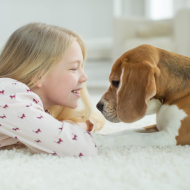
Study explores link between pets and psychiatric disorders
Being around dogs in childhood may reduce a person’s chance of developing schizophrenia later in life, according to new research.
A study published in the journal PLOS ONE explored the link between a person’s exposure to a pet dog or cat during the first 12 years of life and receiving a subsequent diagnosis of schizophrenia or bipolar disorder.
For schizophrenia, scientists were surprised to observe a marked decrease in the risk of a person developing the disorder if they had been exposed to a dog in childhood.
Across the entire range studied, however, they observed no significant link between dogs and bipolar disorder, or between cats and either psychiatric disorder.
Lead author Robert Yolken, a professor of neurobiology in paediatrics at the Johns Hopkins Children’s Centre, said: “Serious psychiatric disorders have been associated with alterations in the immune system linked to environmental exposures in early life, and since household pets are often among the first things with which children have close contact, it was logical for us to explore the possibilities of a connection between the two.”
In the study, researchers analysed a population of 1,371 men and women between 18 and 65, of which 396 people had schizophrenia and 381 had bipolar disorder. The participants were asked to indicate if they had a pet dog or cat during their first 12 years of life.
Researchers conducted the analysis for four age ranges: birth to three, four, five, six to eight and nine to 12. Interestingly, the findings suggest that children who are exposed to a pet dog before their 13th birthday are as much as 24 per cent less likely to be diagnosed with schizophrenia in adulthood.
Yolken continues: “The largest apparent protective effect was found for children who had a household pet dog at birth or were first exposed after birth but before age three.
“There are several plausible explanations for this possible ‘protective’ effect from contact with dogs — perhaps something in the canine microbiome that gets passed to humans and bolsters the immune system against or subdues a genetic predisposition to schizophrenia.”
Scientists say more work is needed to confirm the findings, to search for the factors behind any links and to more accurately define the actual risks of developing psychiatric disorders from exposing infants and children under 13 to pets.



 The RCVS has announced a new version of its 1CPD mobile app, with enhanced features for veterinary surgeons and veterinary nurses to record their continuing professional development.
The RCVS has announced a new version of its 1CPD mobile app, with enhanced features for veterinary surgeons and veterinary nurses to record their continuing professional development.